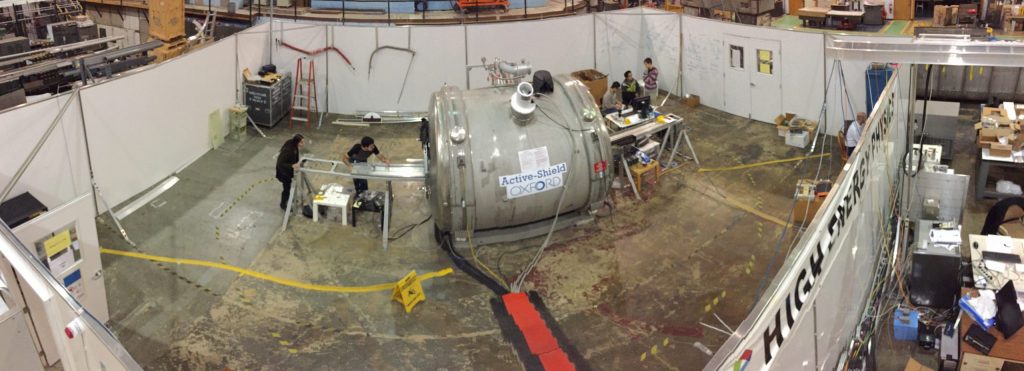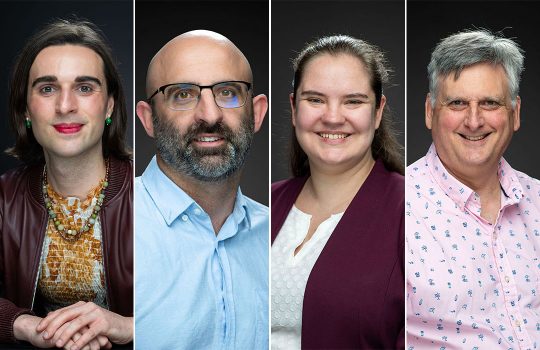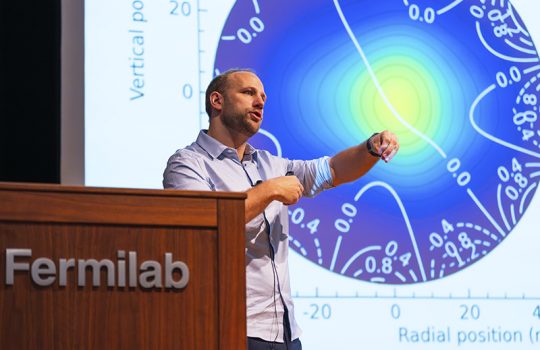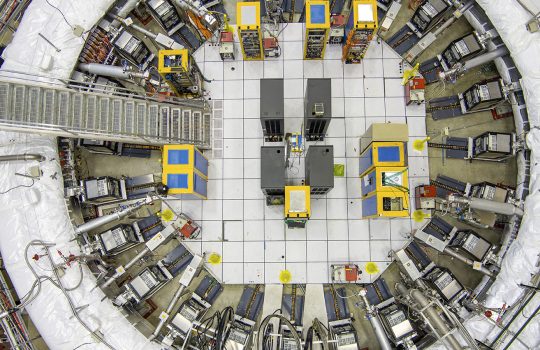This is a version of an article originally published by Argonne National Laboratory.
A limiting factor in modern physics experiments is the precision at which scientists can measure important values, such as the magnetic field within a detector. Scientists at the U.S. Department of Energy’s Argonne National Laboratory and their collaborators have developed a unique facility to calibrate field measurement devices and test their limits inside powerful magnetic fields.
The facility features a solenoid magnet from a former magnetic resonance imaging scanner originally housed at a San Francisco hospital. The magnet produces a maximum field of four teslas — over 400 times the strength of a refrigerator magnet. Its large opening, originally intended to hold a patient during an MRI scan, gives scientists ample space to position devices and machinery inside the magnetic field. The field produced by the magnet is also exceptionally uniform and stable, a requirement for calibrating measurement devices to the ultrahigh precision necessary for many particle and nuclear physics experiments.
“We have worked with several researchers, at Argonne and from other institutions, that need a strong magnetic field and large bore to test their research,” said Peter Winter, physicist and group leader in Argonne’s High Energy Physics Division. “Scientists bring their devices and electronics, and we provide our magnet, expertise and infrastructure to help automate the processes and ensure the success of the tests.”
The team is seeking new users to continue to broaden the facility’s application portfolio.

This panorama view of the 4-tesla solenoid facility shows Argonne’s Midhat Farooq and Joe Grange aligning an NMR calibration setup (left of the magnet), Ran Hong and students improving the calibration motion control system (right of the magnet) and David Flay analyzing current NMR calibration data. Photo: Argonne National Laboratory
Calibration station
A primary application of Argonne’s solenoid test facility is calibrating and cross-calibrating measurement probes to achieve high precision and to add layers of consistency between similar experiments across the world.
Originally, Argonne scientists acquired the magnet to test and calibrate several probes developed by the University of Massachusetts for measuring the magnetic field in the Muon g-2 experiment currently taking place at DOE’s Fermi National Accelerator Laboratory. The test facility allowed the scientists to achieve precise field measurements down to several parts per billion – like measuring the circumference of the Earth down to about two inches.
Precise measurement of the field in the experiment is crucial because the magnetic field strength is a major player in the ultimate determination of “g,” a property of the muon whose ultimate determination will either confirm present theories of particle physics or point to the existence of undiscovered particles.
“This facility has enabled the magnetic field team on Muon g-2 to meet strict goals on the experiment by reducing uncertainties and improving the robustness of our measurements,” said David Kawall, a physicist and professor from the University of Massachusetts. “To the best of my knowledge, there are no peer facilities in the world, and having access to these tools at Argonne has been essential to the success of the magnetic field effort on Muon g-2.”
Future g-2 experiments will be conducted in Japan at the Japan Proton Accelerator Complex of the High Energy Accelerator Research Organization, or KEK. The Japanese collaborators, led by Ken-ichi Sasaki, are using the facility to cross-calibrate their magnetic field probes with the ones used at Fermilab.
“By ensuring our probes all read the same values in the same magnetic field, we are adding certainty to the measurements coming from both g-2 experiments,” said Sasaki, who is a professor at KEK and subsection leader of the cryogenic section in J-PARC.
Another muon experiment, the Muonium Spectroscopy Experiment Using Microwaves, or MuSEUM, will contribute to the Japanese g-2 experiment by precisely measuring the mass ratio of the muon to the electron, a value also included in the g-2 determination.
The experiment at KEK in Japan uses very similar nuclear magnetic resonance calibration probes as the g-2 experiment. The development of the probe for MuSEUM has been led by Toya Tanaka, a graduate student at the University of Tokyo who uses the solenoid facility to calibrate the experiment’s probes. The collaboration between Japan and U.S. scientists will ensure that both g-2 experiments and the MuSEUM experiment have a consistent field measurement.
Helium and Hall probe development
Through a partnership with Fermilab’s Thomas Strauss, another Japanese group, led by Norihito Ohuchi and Yasushi Arimoto from KEK, is using the facility to calibrate their own probe — called a Hall probe — for the upcoming SuperKEKB experiment.
Although less precise than the NMR probes used in the current g-2 experiments, Hall probes can measure not only the magnitude of a magnetic field with the field gradient, but also its direction.
SuperKEKB, a recently upgraded, three-kilometer electron-positron collider, accelerates particles called electrons and positrons very close to the speed of light. The scientists will use the measurements from particles created in collisions to investigate a potential explanation of the matter-antimatter asymmetry in the universe.
The SuperKEKB experiment involves five superconducting solenoid magnets in the beam colliding region. The solenoid fields have a heavy influence on the efficiency of the collisions. To elevate the beam colliding efficiency, the team will use the calibrated data of Hall probes to make more precise solenoid field profiles.
“Using Argonne’s test facility, we believe we can improve the accuracy of the Hall probes by one order of magnitude,” said Ohuchi, who is a professor at KEK and leader of the superconducting magnet group in the Accelerator Laboratory. “This will enable us to map the complex magnetic fields produced by the SuperKEKB magnets and improve the quality of the beams.”
Another upcoming experiment at Fermilab, called Mu2e, will also employ Hall probes for field mapping. The experiment uses a solenoid magnet like Argonne’s, but bigger, to measure muon interactions. The reigning Standard Model of particle physics allows muons to decay in a specific way, but for this experiment, scientists will search for a “forbidden” interaction whose occurrence would violate the Standard Model and point to new physics.
The ability of Hall probes to measure the direction of a field makes it the preferred probe for the Mu2e experiment, but the added capability necessitates even more quality control. Argonne scientists have taken the responsibility for field mapping in the Mu2e experiment, and they are using the test facility to calibrate the probes.
“If you have a slight misalignment between the direction from which the probe reads its measurement and where the field is actually pointing, the measurement can veer away from the true value very quickly,” said Bob Wagner, leader of the field mapping team at Argonne. “Our magnet allows us to align the axes of the probes with the field and with each other.”
As Hall probes become more accurate and precise with the help of Argonne’s test facility, a new probe — one that uses helium — is making its debut. A group of researchers from the University of Michigan, led by Professor Tim Chupp and Midhat Farooq, developed the new calibration probe to act as an additional check for measuring fields
The helium isotope in the probe, helium-3, is an inert gas that behaves differently from the water used in traditional probes and has the potential for greater accuracy.
“We used the Argonne test magnet to cross-calibrate our probe with two water probes, including one with the same design as the UMass probe, and found agreement with high precision, confirming that any effects we had not considered are pretty small,” Chupp said. “Our next step is cross calibration of the UMass probe with an improved helium-3 probe that will be even more precise.”
Farooq and team published a paper in Physical Review Letters in June 2020 on the success of their helium probe.
A growing list of applications
Since accepting its first group of external users — scientists from Stony Brook University that tested a magnetic cloak to shield electronics in experiments — the facility’s applications and user base have grown significantly.
In addition to probe calibration, the magnet has also aided in testing and development of a variety of experimental equipment. Argonne’s Junqi Xie, a scientist in the lab’s Physics division, uses the magnet to develop detectors that operate in high magnetic fields for photosensing applications. The detectors will have future applications in the Electron-Ion Collider to be built at DOE’s Brookhaven National Laboratory.
Fermilab recently used the magnet to test their laser metrology systems that they use to measure distances and align equipment in experiments. They tested the ability of several laser trackers, which can measure distances at the submillimeter level, to remain accurate in the presence of high magnetic fields.
“The facility has also been helpful for training the next generation of scientists,” Kawall said, “and the international collaborations formed will be of enduring benefit.”
For inquiries about using the magnet for research and development, contact Peter Winter at winterp@anl.gov.
Argonne National Laboratory seeks solutions to pressing national problems in science and technology. The nation’s first national laboratory, Argonne conducts leading-edge basic and applied scientific research in virtually every scientific discipline. Argonne researchers work closely with researchers from hundreds of companies, universities, and federal, state and municipal agencies to help them solve their specific problems, advance America’s scientific leadership and prepare the nation for a better future. With employees from more than 60 nations, Argonne is managed by UChicago Argonne, LLC for the U.S. Department of Energy’s Office of Science.
The U.S. Department of Energy’s Office of Science is the single largest supporter of basic research in the physical sciences in the United States and is working to address some of the most pressing challenges of our time. For more information, visit https://energy.gov/science.



